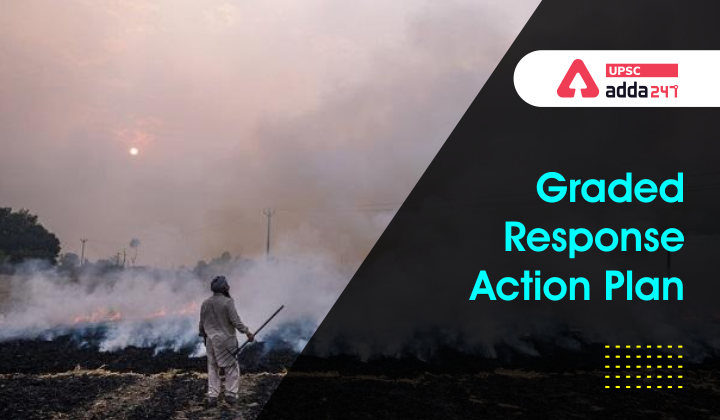Table of Contents
Graded Action Response Plan: Relevance
- GS 3: Conservation, environmental pollution and degradation, environmental impact assessment.
Graded Action Response Plan: Context
- Recently, a subcommittee of the Commission for Air Quality Management in Delhi-NCR and adjoining areas (CAQM) has suggested few steps to contain air pollution in the region.
Graded Action Response Plan: Key points
- Curbs like bans on diesel generators and the use of coal-fired ovens should begin in Delhi and the National Capital Region (NCR) on October 15 irrespective of the air quality at the time.
- Also, activities such as routine mechanised sweeping should also be initiated.
- The committee also recommended that all ‘poor’ and some ‘very poor’ protocols of the Graded Response Action Plan (Grap) be activated.
- It also recommended that some of the actions under the ‘very poor’ category should also commence from October 15, though the air quality index (AQI) is expected to remain in the ‘satisfactory’ to the ‘moderate’ category range in the NCR.
WHO Global Air Quality Guidelines 2021
About Graded Action Response Plan
- The Delhi Graded Response Action Plan is a set of emergency measures that was approved by the Supreme Court in 2016.
- It comes into effect when the air quality index (AQI) in Delhi and the NCR breach certain thresholds.
- The plan, as such, does not include action by various state governments to be taken throughout the year to tackle industrial, vehicular and combustion emissions.
International Day of Clean Air For Blue Skies
GRAP: Two successes
- It has created a step-by-step plan for the entire Delhi-NCR region.
- It has brought on board several agencies: all pollution control boards, industrial area authorities, municipal corporations, regional officials of the India Meteorological Department, among others.
How has GRAP helped?
- Fixed accountability: Executive actions to be taken under a particular air quality category are clearly marked.
- Coordination among as many as 13 agencies from four states—Delhi, Uttar Pradesh, Haryana and Rajasthan—is simplified to a degree because of the clear demarcation of responsibilities.
- Three major policy decisions:
- closure of the thermal power plant at Badarpur
- bringing BS-VI fuel to Delhi before the deadline set initially
- ban on Pet coke as a fuel in Delhi-NCR.
- The initial mandate of EPCA was to ensure that Delhi’s bus and auto fleet moves entirely to CNG — a mammoth task that played a crucial role in cleaning Delhi’s air in the late 2000s.
GRAP actions
| Severity | Pollution level | Actions |
| Severe+ or Emergency | PM 2.5 over 300 µg/cubic metre or PM10 over 500 µg/cu. m. for 48+ hours | · Stop entry of trucks into Delhi
· Stop construction work · Introduce odd/even scheme for private vehicles. · Task Force to decide any additional steps including shutting of schools.
|
| Severe.
|
PM 2.5 over 250 µg/cu. m. or PM10 over 430 µg/cu. m. | · Close brick kilns, hot mix plants, stone crushers.
· Maximise power generation from natural gas. · Encourage public transport, with differential rates. · More frequent mechanised cleaning of road and sprinkling of water. |
| Very Poor | PM2.5 121-250 µg/cu. m. or PM10 351-430 µg/cu. m. | · Stop use of diesel generator sets
· Enhance parking fee by 3-4 times · Increase bus and Metro services. · Apartment owners to discourage burning fires in winter. · Advisories to people with respiratory and cardiac conditions to restrict outdoor movement. |
| Moderate to poor | PM2.5 61-120 µg/cu. m. or PM10 101-350 µg/cu. m. | · Heavy fines for garbage burning.
· Close/enforce pollution control regulations in brick kilns and industries. · Mechanised sweeping on roads with heavy traffic and water sprinkling. · Strictly enforce ban on firecrackers. |




 TSPSC Group 1 Question Paper 2024, Downl...
TSPSC Group 1 Question Paper 2024, Downl...
 TSPSC Group 1 Answer key 2024 Out, Downl...
TSPSC Group 1 Answer key 2024 Out, Downl...
 UPSC Prelims 2024 Question Paper, Downlo...
UPSC Prelims 2024 Question Paper, Downlo...





